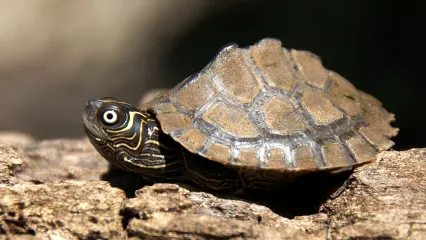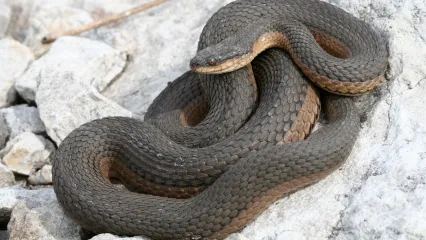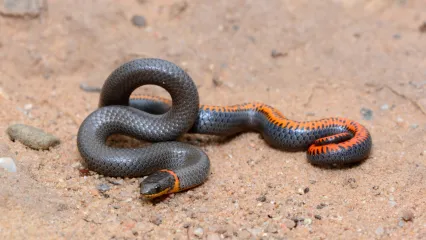
Description
Mississippi map turtles are moderate-sized aquatic turtles with inconspicuously marked dark olive to brown plastrons. Irregular paired circles of lines on the carapace may be apparent, particularly in younger turtles. The carapace has a mid-dorsal keel, most evident on the first three mid-dorsal scutes, as well as a dark mid-dorsal line. Marginal scales on the posterior edge of the carapace are serrated giving an irregular appearance to the back of the shell. The plastron is light colored, usually cream or yellow and has a complex and variable set of dark markings. The dark-colored head has a number of bright yellow stripes extending up, back, and down on the neck from the orbit of the eye. Although these can vary among individuals, a large crescent-shaped yellow mark behind the eye distinguishes Mississippi map turtles from all other turtles in the area. Red-eared Sliders in Oklahoma have a distinct and elongate red mark behind the eye and Gulf Cooters have no enlarged colored marking behind the eye (although they do have a series of yellow stripes extending back and down from the eye orbit).
Because of their life-history (long time to reach sexual maturity and repeated reproduction over a long lifetime with high nest and juvenile mortality), harvest of adult females can have highly detrimental effects on populations.
Size
Females range from 6-10 inches in length while males are 3 ½ - 5 inches.
Habitat
Mississippi map turtles occur in rivers, large streams, and lakes across eastern Oklahoma. In North America, the west–east distribution extends from central Texas to southern Indiana and western Tennessee and north–south from central Illinois to just north of the Gulf Coast of eastern Texas, Louisiana, and Mississippi.
Life Cycle
Mississippi map turtles are strictly aquatic turtles leaving the water to nest and occasionally to find new aquatic habitats. The diet consists primarily of aquatic insects, and they appear to prefer midge (chironomid) larvae. Nevertheless, they also feed on carrion, mollusks, and some aquatic vegetation. Mating occurs in spring and females deposit several clutches of 6–7 eggs through the summer. Eggs hatch from July through early September and hatchlings are just over one inch in plastron length. Males reach sexual maturity at a size of about three inches in plastron length after about three years whereas females reach sexual maturity at a size of about six inches in plastron length after six or seven years. Similar to most other turtle species, Mississippi Map Turtles have a life history characterized by late maturity, long life, and repeated reproduction over a long female lifetime. As in other turtles, nest and juvenile mortality are probably high.
How To Observe
During spring, summer, and fall, these turtles bask on logs and rocks and are easy to observe using binoculars. However, these are shy turtles, and often are the first to enter the water when disturbed. During early summer, they can occasionally be observed crossing roads when females search for nesting sites.
(This profile was created by Dr. Laurie Vitt as part of a partnership between the Wildlife Department and the Sam Noble Oklahoma Museum of Natural History. It was funded as part of a larger State Wildlife Grant to survey and inventory amphibians and reptiles of the Wildlife Management Areas of Oklahoma: T-35-P-1.)


